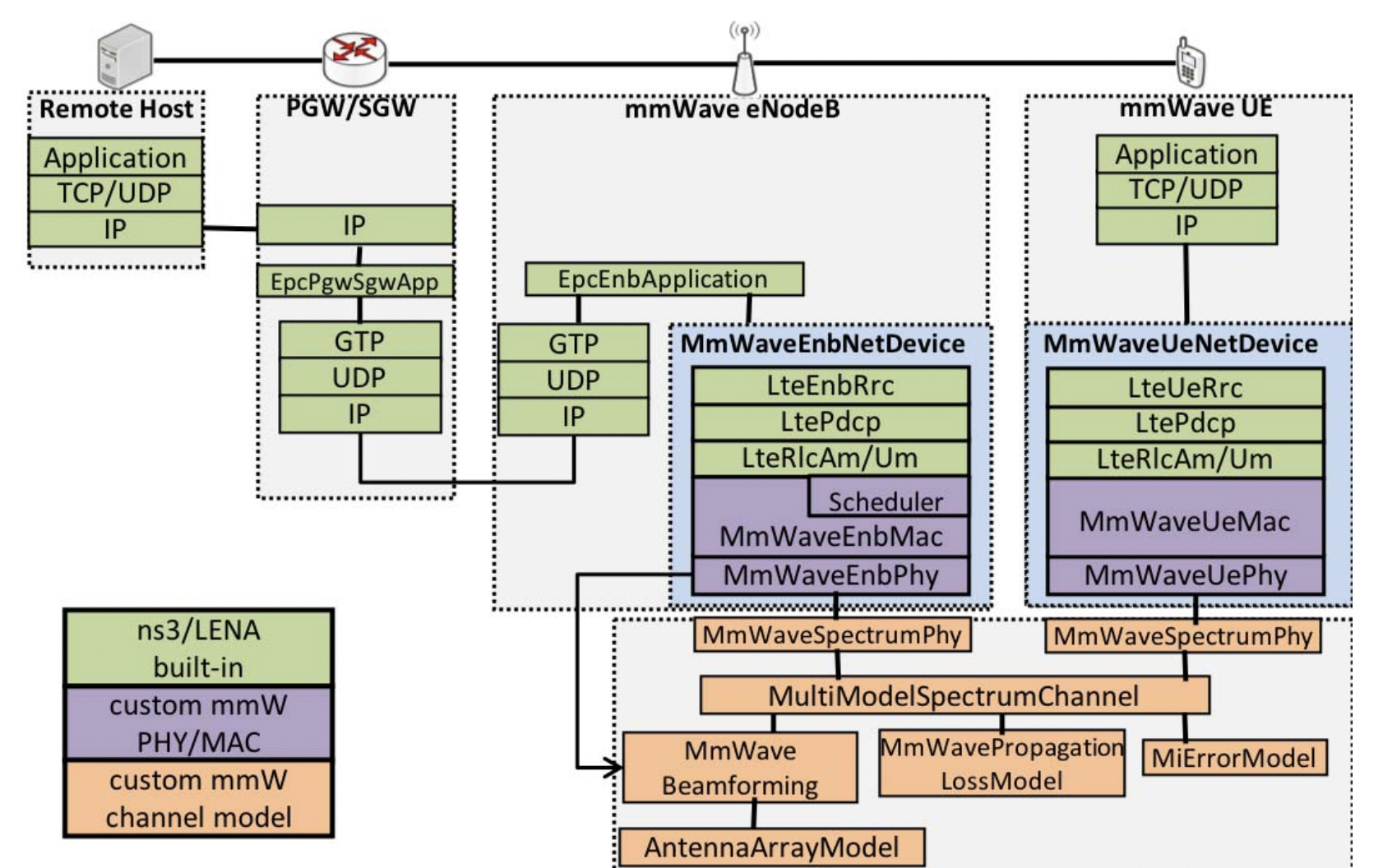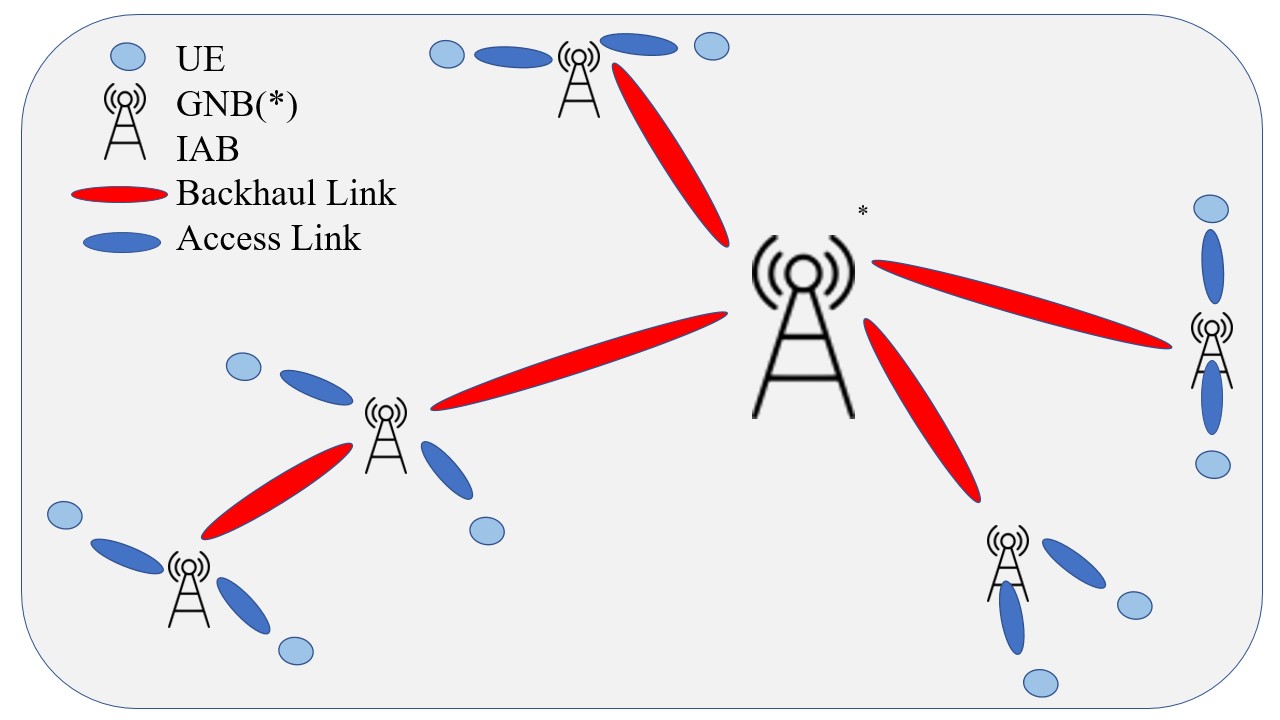Published on: 15 July, 2022
In this blog, we introduce the Ns-3 mmWave module[1], which enables packet-level simulations of 3GPP-based protocols for the purpose of verifying novel protocols and algorithms. The Ns-3 mmWave module is an Ns-3-based open-source tool that enables full-stack analysis, metrics such as throughput and latency at the application layer, including physical layer performance indicators such as Signal to Interference and Noise Ratio (SINR). First, we briefly describe Ns-3 before introducing the Ns-3 mmwave module. Later, some noteworthy extensions are discussed. 
Figure 1. Class diagram of the end-to-end mmWave module [6]
Ns-3 [2]
The Ns–3 discrete-event network simulator is a very powerful tool that communication and networking researchers may use to design new protocols and analyze complicated networks. It is the successor to Ns–2, a time-tested tool that has been used by the networking industry to build and validate network protocols for over a decade. Ns–3 is an open-source project that can be downloaded from the project’s website. A strong community of researchers from business and academia have added various modules to the simulator’s core, enabling it to replicate a broad range of wireless and wired networks, protocols, and algorithms. The Ns–3 website has comprehensive documentation on the models, both in terms of their design and what they may be used for. Additionally, the documentation includes a detailed tutorial on how to install, configure scenarios and topologies, manage statistics gathering, and record valuable messages in Ns–3. It is also an indispensable tool for my colleagues and I, as part of MINTS and SIGNET. Listed below are three notable Ns-3 tools that make-up the core of my personal toolbox:
- The WiGig module [3]: a wireless network interface controller based on IEEE 802.11ad/ay WLAN.
- The Qd channel repository [4]: offers implementations of channel models that enable the importation of ray tracing channel models into Ns-3 tools.
- The simulation execution manager (SEM) [5]: this tool enables the execution of several Ns-3 scripts, which leads to the ability to manipulate the results and collect them in a user-friendly manner.
Ns-3-mmWave
The Ns-3-mmWave module was created by NYU Wireless Research Centre and the SIGNET Research Group, University of Padova to enable end-to-end simulations of 3GPP-style cellular networks. The module includes a variety of precise statistical channel models and the ability to incorporate specific measurements or ray tracing data. The physical and medium access control layers are modular and highly adjustable, simplifying algorithm integration and comparing orthogonal frequency division multiplexing numerologies. The module is connected to the Ns–3 Long Term Evolution (LTE) module’s core network in order to enable full-stack simulations of end-to-end connection as well as advanced architectural features such as dual connectivity.
Its main features are:
- Support for a wide range of wireless channel models:
- 3GPP TR 38.901
- Ray tracing
- Measured traces
- Customizable MAC and PHY classes based on 3GPP NR frame structure and numerologies
- Tuneable schedulers for supporting dynamic TDD
- Dual connectivity with LTE base stations
Several other examples can be found in [6]. In addition, there are a couple of extensions that can be used with Ns-3 mmWave module. We go through some of them briefly below.
Millicar [7]
This is an Ns-3 module extension for the simulation of Vehicle-to-Vehicle (V2V) networks operating in the mmWave spectrum. V2V communication has made it possible for cooperative autonomous driving to increase road safety and traffic efficiency. The mmWave spectrum, in particular, shows considerable potential for V2V communications, since the enormous bandwidth available enables the realization of high-data-rate links. This potential, however, is limited by the high path loss and the high penetration loss associated with these frequencies. It is thus critical to assess the practical viability of deploying mmWave-based technology in a vehicle environment, given the stringent latency and throughput requirements of future automotive applications. MilliCar, the first Ns-3 module for V2V mmWave networks, includes a detailed implementation of the sidelink Physical (PHY) and Medium Access Control (MAC) layers based on the latest NR V2X specifications, the 3GPP standard for next-generation vehicular systems. This open-source module enables researchers to analyze potential design solutions and their relative performance using an end-to-end full-stack approach in a swift and efficient manner, hence motivating more study on the subject. The full description of this module can be found here [8].
Integrated Access and Backhaul (IAB) [9]
To address the extreme isotropic path loss and hard propagation conditions seen at high frequencies, a dense base station deployment is necessary. However, base stations in practice are connected with fiber optic drops (cables), which enable fast and reliable wired backhauling, but make denser deployments economically infeasible. To solve this issue, the 3GPP is evaluating the topic of Integrated Access and Backhaul (IAB), which refers to the potential of delivering wireless backhaul to mobile terminals. The tailor-made module enhances the capabilities of the current Ns-3 mmWave module to enable advanced IAB functionality and the analysis of IAB architecture end-to-end performance in terms of experienced throughput and communication latency using system-level full-stack simulations. Finally, it provides strategies for optimizing wireless backhaul solutions in resource-constrained and crowded mmWave environments. Further details are discussed in the corresponding publication [10].

Figure 2. IAB setup example. A gNB communicates with IAB nodes by backhaul links and IAB nodes grant the connection of UEs to Internet by Access link.
If you were able to stick until the end and can’t wait for more content and you also want to know about us and our projects, you can always follow our social media channels.
References
[1] https://github.com/nyuwireless-unipd/ns3-mmwave
[3] https://github.com/wigig-tools/wigig-module
[4] https://github.com/signetlabdei/qd-channel
[5] https://github.com/signetlabdei/sem
[6]M. Mezzavilla et al., “End-to-End Simulation of 5G mmWave Networks,” in IEEE Communications Surveys & Tutorials, vol. 20, no. 3, pp. 2237-2263, thirdquarter 2018, doi: 10.1109/COMST.2018.2828880.
[7] https://github.com/signetlabdei/millicar
[8]Drago, Matteo, et al. “MilliCar: An ns-3 module for mmWave NR V2X networks.” Proceedings of the 2020 Workshop on ns-3. 2020.
[9] https://github.com/signetlabdei/ns3-mmwave-iab
[10] Polese, Michele, et al. “End-to-end simulation of integrated access and backhaul at mmWaves.” 2018 IEEE 23rd International Workshop on Computer Aided Modeling and Design of Communication Links and Networks (CAMAD). IEEE, 2018.





